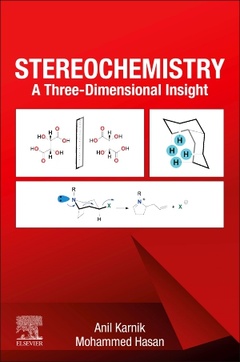Stereochemistry A Three-Dimensional Insight
Auteurs : Karnik Anil V., Hasan Mohammed

Stereochemistry: A Three-Dimensional Insight draws on the knowledge of its expert authors, providing a systematic treatment on the fundamental aspects of stereochemistry, covering conformational aspects, configurational aspects, effects of bulkiness, stereoelectronic effects on properties of molecules, and the genesis of enantiomerism, among other topics. Visuals and exercises are included to consolidate the principles learned, and the contents are carefully structured to prepare readers for predicting and organizing reaction components to obtain desired stereochemical outcomes. This book is an indispensable guide for all those exploring stereochemistry within their work.
The principles of stereochemistry are fundamental to understanding chemical behavior and can provide insights into a whole range of problems, from unusual selectivity and unexpected behaviors, to abnormally fast reactions and surprising biochemical preferences. However, understanding and exploring these 3D effects can be difficult within a 2D medium. This book has been designed to address this problem, providing foundational guidance on the principles and applications of stereochemistry that are fully supported by multimedia visuals.
Part I Fundamentals of stereochemistry1. Basic concepts of structure and stereochemistry2. Symmetry and point groups3. Elements of chirality and chiral stereoisomerism
Part II Enantiomer properties4. Chiroptical properties: Origin and applications5. Configurational analysis6. Racemates: Properties and methods of resolution
Part III Conformations and conformational analysis7. Conformation of acyclic molecules8. Conformations of cyclic, fused and bridged ring molecules
Part IV Stereochemical reactivity9. Prochirality10. Diastereomeric transition states and stereoselectivity11. Chiral analytical chemistry12. Pericyclic reactions
Dr. Mohammed Hasan has graduated with a PhD in Organic Chemistry form University of Mumbai, working with Prof. Anil V. Karnik on the topic “Studies In Chiral Molecular Recognition. Post PhD, He began his career as Research Scientist at a pharmaceutical industry, CIPLA Ltd.; working on synthesis of complex, chiral anti-cancer drugs. Later, he went on to gain significant international post-doctoral research experience in Europe and China; working on various synthetic and supramolecular chemistry aspects of stereochemistry. His research interest includes synthetic organic chemistry, chirality, supramolecular chemistry, optical methods and green chemistry. He has many publications in high impact factor international journals. Currently, he is a visiting researcher at the Department of Chemistry, University of Mumbai.
- Combines foundational concepts and definitions with examples of stereochemistry in practice
- Highlights the conformational and configurational impact of atomic arrangement on chemical behavior
- Outlines methods of analysis
- Provides practical exercises and detailed multimedia visuals to support learning
Date de parution : 07-2021
Ouvrage de 620 p.
15x22.8 cm
Thème de Stereochemistry :
Mots-clés :
?Absolute configuration; Asymmetric; Asymmetric synthesis; BINAL-H; Chiral analysis; Compounds; Configuration; Configuration; Conformation; Correlative methods; Crystal morphology; Diastereoisomers; Diastereomers; Diels-Alder reaction; Dissymmetric; Dynamic stereochemistry; Enantiomers; Enantiopure compounds; FMO; Fluorescence; HMO; HOMO; Homomers; Homomorphic ligands; Interaction; Isotropic materials; LCAO-MO; LUMO; Magnetic fields; Molecular geometry; Molecular orbital; NMR; OYE; Optical stereoisomerism; Orbitals; Point group; Polarised light; Principles; Pro-chirality; Projection formulae; Pyrolytic elimination; Racemates; Stereoisomerism; Symmetric; Symmetry; Symmetry elements; Symmetry operations; UV-VIS spectroscopy; X-ray; Zimmerman-Traxler model



